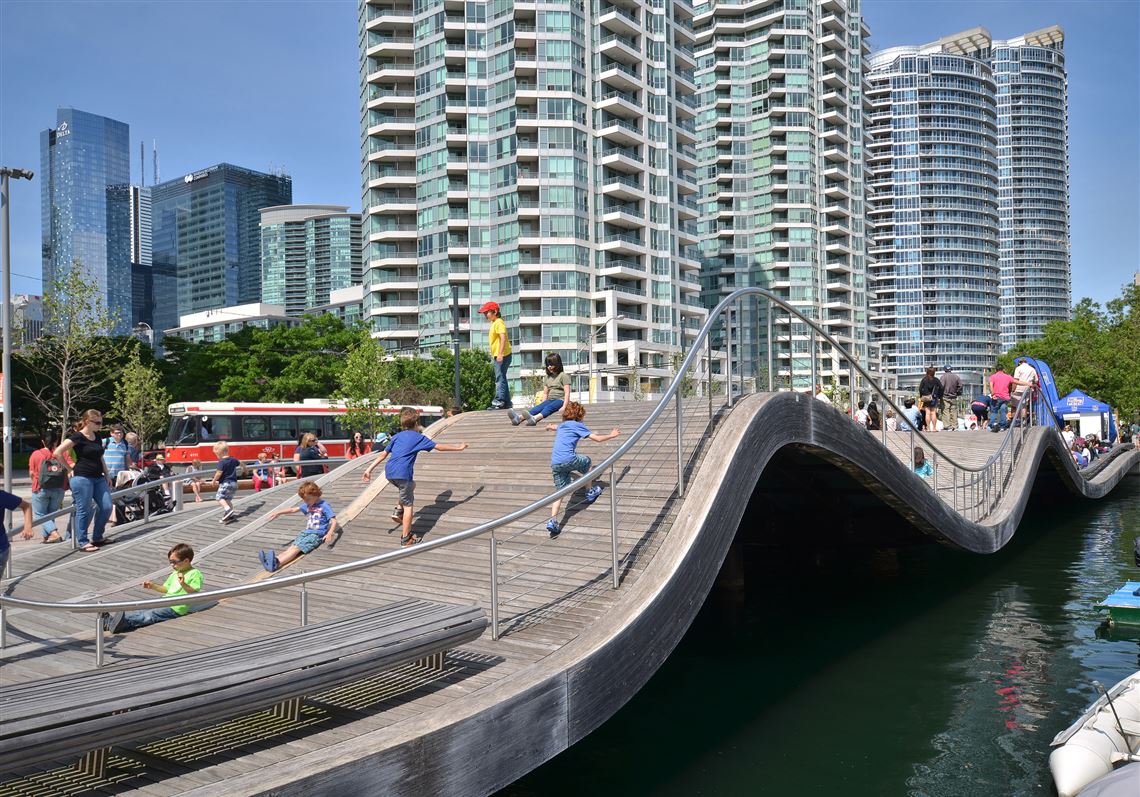TORONTO — It’s rush hour on the edge of Lake Ontario on this early October afternoon. The maple trees are shouldering their traditional patriotic shade, and the last few sailboats are tacking across the dark blue harbor. And Queen’s Quay, the newly remade downtown boulevard, is a blur of movement.
Cyclists pass runners, with a polite Canadian “ping” of their handlebar bells. Toddlers slide down the sloping panels on artfully curved boardwalks, called wave decks, along new marinas. Tourists angle for selfies with the iconic CN Tower as backdrop.
As a streetcar pulls up, a driver mistakenly blocks its path — forgetting that the street’s massive redesign makes room for all kinds of wheels, including skateboards. After a friendly after-you exchange, traffic smoothly resumes.
Kudos, Toronto. Over the past few decades, you’ve gone from crumbling to crispy.
Toronto’s big remake embraces its waterfront in much the same way that Pittsburgh has — although on a vastly larger scale. The $1.5 billion (CDN) public project shades not only its Pennsylvania neighbor; at almost 2,000 acres, it also dwarfs New York City’s recent Battery Park overhaul and London’s Canary Wharf.
This fall, Canada’s biggest city is celebrating the end of the construction cones.
The waterfront is open, and the locals clearly love it. And while the city center feels brand new, its ethnic neighborhoods are still thriving.
The lake was always great. The problem was the lakefront, which by the mid-20th century was a polluted industrial relic blocked by the Gardiner Expressway. With its central portion complete, the plan that waterfront designers call “the new blue edge” is expanding along the East Bayfront, adding glistening towers, parks, and promenades that accommodate the city’s explosive growth.
You’ve heard about that, right? How Toronto now boasts 240 ethnic groups and speaks 140 languages? As Post-Gazette reporter Mark Roth reported last year, 49 percent of its 6 million residents were born in another country. The Queen’s Quay crowds are so completely multinational it’s almost impossible to guess what country you’re actually in.
The population boom means that Toronto needs more affordable housing and more recreation space, and developing the waterfront allows it to do both.
“Our master plan was parks first, development second,” says Chris Glaisek, vice president of planning and design for Waterfrontoronto, as we stroll Queen’s Quay. Twenty-four parks are slated as part of the redevelopment, connecting eastern city neighborhoods to trails and water views. (Sound familiar? Pittsburgh’s Urban Design Associates and landscape designer Michael Van Valkenburgh, who have put their stamps on the local scene, have also worked in Toronto.)
We pass lunchtime strollers heading for permanent pink umbrellas and a sandy shore at Sugar Beach, a park named in honor of the Redpath Sugar Refinery next door.
At Sherbourne Commons, just east of the financial district, cranes are swinging over the street. They’re building luxury condominiums designed by Arquitectonica, a buzzy Miami-based firm. But as Mr. Glaisek points out, the waterfront plans makes room for plenty of handsome affordable housing, universal Wi-Fi and streetcars. And, of course, ice skating: Several of the new developments feature spray parks that convert to open-air rinks.
Public art? Green infrastructure? Check and check, and hand in hand: Sherbourne’s Commons’ “Light Showers” sculpture illuminates a waterfall, part of a stormwater management scheme that recycles clean water into the lake.
I borrow a two-wheeler from a city bike share stand for a flat and easy ride out of downtown. The cityscape morphs from pale glass towers to the swooping Art Gallery of Ontario, a redesign by Toronto native Frank Gehry. A riot of Mandarin neon signs greet me as I roll through Chinatown. When the sidewalks start sprouting vegan cafes and vintage clothing shops, I’ve arrived at Kensington Market, a laid-back university district that links the globe.
As my husband and I debate the local dinner options, we’re spoiled for choice: pasta in Little Italy? Bibimbap in Koreatown? We choose Bar Raval, serving Spanish tapas in a cozy Barcelona-themed cafe. Heaters keep the patio crowd warm as they lean against a window bar, toasting the sunset.
With only a few days left in the boating season, we decide to splurge before leaving town. At Harbourfront Centre, we book an hourlong spin in a small powerboat. The tiny two-seater looks like the kind of 1960s’ launch that Inspector Clouseau might choose, with barely enough horsepower to spin its propeller. But it gives us a chance to buzz the waterfront.
Carefully avoiding the perimeter of Billy Bishop Airport, we cruise toward the Toronto Islands, a 10-minute ride across the harbor. Ward Island, Centre Island and Hanlan’s Point depend on boats and ferries — no cars allowed. The islands feel, appropriately, like an English country landscape, with stone bridges and cottages. We emerge from the quiet waterways and catch the city in sunset glory, with western light painting the skyscrapers orange.
In a few more years, thousands of new residents from all over the globe will call this waterfront home. Right now, the curtain on its new chapter is rising, hoisted by those cranes on the horizon.
Christine H. O’Toole is a freelance writer based in Mt. Lebanon (christinehotoole.com).
First Published: October 21, 2015, 4:03 p.m.
















